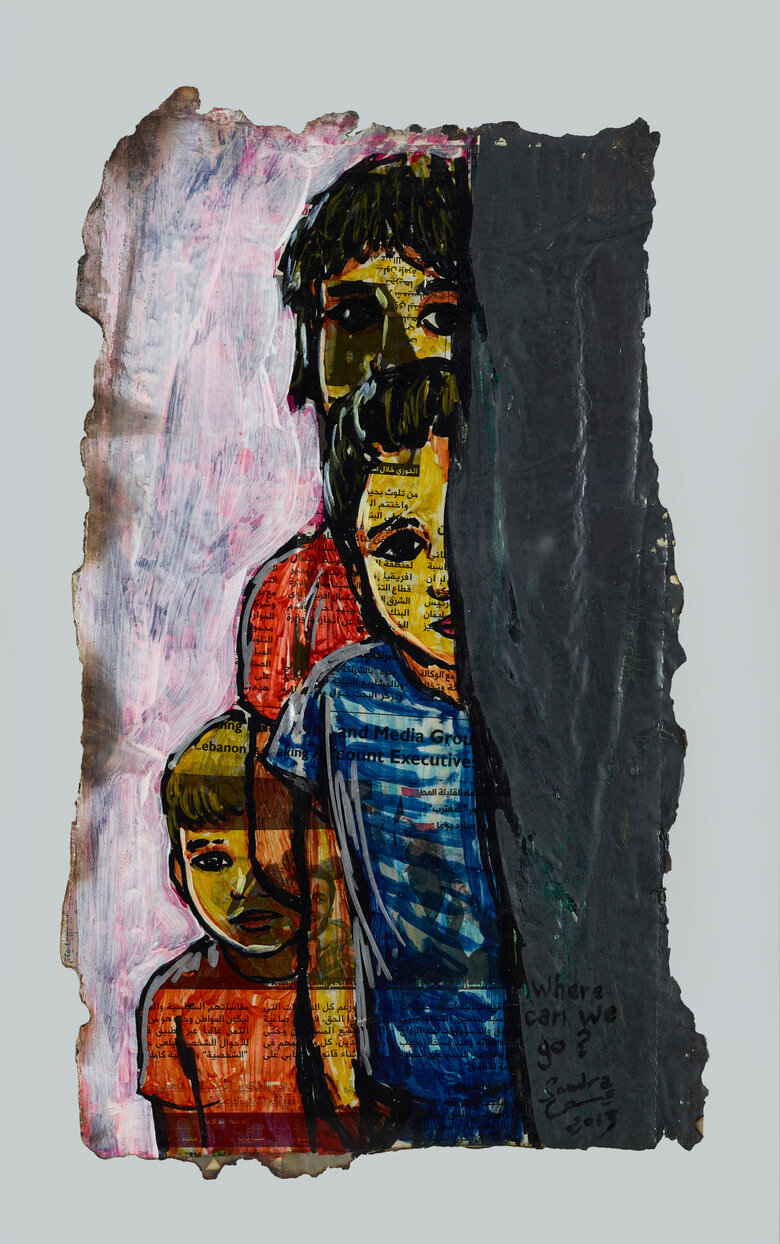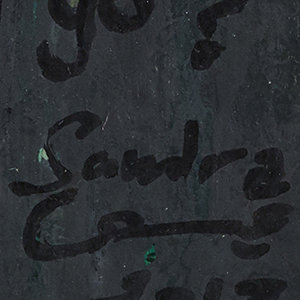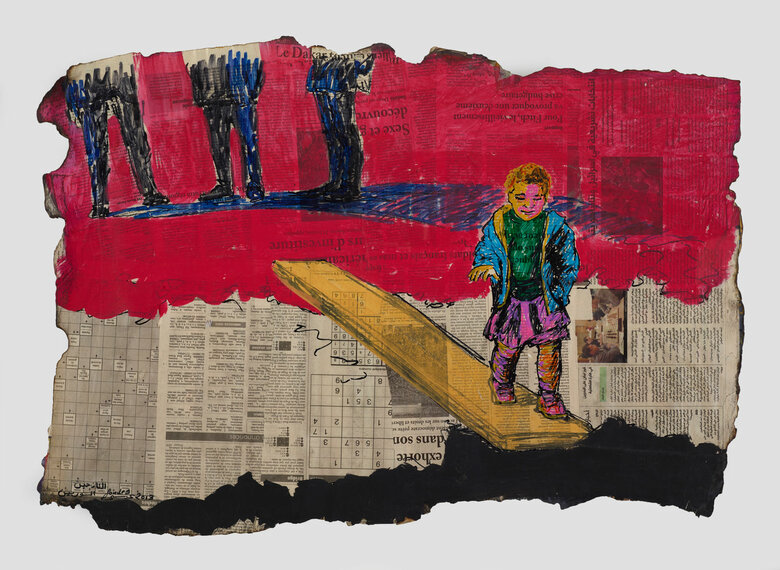Sandra Issa is a contemporary visual artist born in 1984 in Byblos, Lebanon, to a Belgian mother and a Lebanese father[i]. She studied visual arts in Lebanon, after which Issa obtained a Bachelor's...





Sandra Issa is a contemporary visual artist born in 1984 in Byblos, Lebanon, to a Belgian mother and a Lebanese father[i]. She studied visual arts in Lebanon, after which Issa obtained a Bachelor's...
Sandra Issa is a contemporary visual artist born in 1984 in Byblos, Lebanon, to a Belgian mother and a Lebanese father[i]. She studied visual arts in Lebanon, after which Issa obtained a Bachelor's degree in 2008 and a Master's degree in 2009 in Visual Arts from the Ecole Regionale Superieure d’Expression Plastique (ERSEP), Tourcoing, France[ii]. In 2015, she participated in an artist residency in Moncontour, France, after which she moved to Tournai, Belgium. During those years, Issa attended art residencies in Iceland (2016), Oman (2016) and Namur, Belgium (2017)[iii]. Her work includes painting, drawing, installation art, and live painting ventures.
Issa’s artistic creations investigate the complexities of our contemporary history, which are personified through the portraits of ordinary men and women that Issa creates. Her works explore how people assign value to the individual in a global economy and how they consume news and filter media information. In many of her works, Issa uses newspapers, news photographs, and fabric as a surface to convey an inherent message. Issa explains that “newspapers are the noise of the world, the voices of politicians and influential people who are making the news;” those in power who chart modes of social and political control. Her more recent works dive into contemporary forms of communication and news dissemination, such as mass media and social media.
Even more, Issa depicts the story of ordinary people that we see in the news by painting foreign yet expressive faces on the surface of newspapers and assembled fabrics. The surface, Issa explains, represents the “membrane of the world.” Old clothes, cloth, and torn furniture constitute the fabrics she uses; they function as a “second skin” that carries the culture and identity of people who wear and use them. Whereas the newspapers represent the “noise” composed of the voices of politicians and influential people who make and shape the news[iv].
For instance, The Skin of the World, 2013, one of Issa's projects, exemplifies media critique; it portrays the image of “the refugee” that exists in a liminal state – stuck in a state of transition, a space of uncertainty, and in limbo. Another example is Crossing Borders, 2013, part of the Ramzi and Saeda Dalloul Art Foundation’s (DAF) collection in Beirut. The background surface consists of newspaper clippings that create a patchwork of printed texts and images. Glued together, the edges are then burned to look like “torn pieces of our world.”[1] The artwork’s composition is divided into three horizontal sections: the first row is wide and painted in bright yet faint red. The middle part is kept neutral and consists of glued newspaper clippings, while a thin bottom row is painted in dense black with an askew edge. The three bands of colors — red, neutral (white), and black — resemble the colors of the Syrian flag. Crossing Borders, 2013, depicts the flow of displaced Syrians and Syrian refugees escaping the war in Syria. [v]. At the central left of the painting, we see a child dressed in bright blue, magenta, green, and yellow standing at the edge of a yellow plank that resembles a diving platform. Sketched in 3D shape, the plank cuts through the background, beginning from the blood-red upper part, through the newspaper middle, and then to the edge of the thick black lining. As such, the child seems to stand at the edge of a black abyss. The red and deep black frame the child, representing a bloody past and a dark future.
Moreover, Issa lays bare the faces of different groups of marginalized peoples that lie at the center of political turmoil and systems of social inequality. Issa’s art is inspired by the social consequences of violence and conflicts in the Middle East, Africa, and Asia and by the turmoil in the MENA region, including the impact of European and Western states on regional politics. Her themes underline regimes of race, patriarchal structures, and gender discrimination, as well as forced migration and ethnic violence.[vi] The Arab Spring (2011-2012) unleashed a quest for change in the artist, namely, calling for social equality and political freedom in the MENA region. The consequent repression and the displacement of millions of people awoke in her anger and despair.[vii] Later, the uprisings of 2019 in Lebanon and other countries revived Issa’s fervor for explicit revolutionary messages in her art. It should be noted that Issa's artworks speak not only of hardship and privation. Her artworks celebrate minorities and depict cultural diversity, ethnic pride, dignity, freedom, rage, and resistance. They also celebrate love and solidary with queer movements and LGBT rights.
Issa's study of the entanglement of dominant power sources (governments, media, etc.) and cultural formations peaks in her work on combat and martial arts. In Energy and Movement, 2007-2009, in an era of war, Issa portrays a commentary on the culture of combat through bodily movements. She researches movement and the flow of energy that constitute martial arts. The drawings are executed in pencil, charcoal, pen, or pastel. The swift strokes transmit the violence expressed through the body in movement.[viii].
The project Turkish Wrestling, 2007, is inspired by the combination of the Turkish national sport, oil wrestling, and the encouragement of violence that she saw in the 10th International Istanbul Biennial slogan: "Not only possible but also necessary optimism in the age of global War." She explains that the slogan is a reflection of the Turks' encouragement to the government to attack the Kurdish separatist party. The mixed media pictures are formed by applying ink drawings of combats, newspaper sheets, and words, as well as photos of protesters, military, and planes on the posters of the Biennial.[ix].
Issa's work aims to point the finger toward an unjust world. With her images, she fights for the rights of minorities and marginalized groups. She compares the aim of her artworks to that of demonstration, namely encouraging people to stay "woke."[x]”. She has produced images in support of LGBTQ+ rights. An example is the work she did for the occasion of the International Day Against Homophobia, Transphobia, and Biphobia, 2017[xi]. The warm pictures of people showing physical affection to one another, together with explicit texts like "love are love," show that this project aims to promote tolerance and proclaim a safe space where anybody can express love towards anybody. Issa also takes a stand against racism. In black and white, 2017[xii], "the white" is represented as a mass of identical masks surrounding two well-defined black people. Issa did the opposite of what media often does; she humanized the minority and left those that form the majority in an indistinguishable mass. Issa's art often mirrors the demonstrations she has taken part in[xiii]. In Stop Sexism, 2021[xiv], she depicts a protest where people carry slogans against patriarchy. The red color, used as the background and to define facial expressions, translates the ferocity of the sentiments carried by the female protesters. Thus, her work became an act of activism, relaying bold statements through her technique.
Sandra Issa's work offers an inflamed critique of contemporary social problematics, such as combat, displacement, patriarchy, and ethnic and gender discrimination. In particular, she analyses the entanglement of power dynamics exercised by governments and cultural patterns. In addition, she enquires about the influence of news spread by mass media on people's lives and world views. Throughout her career, Issa has constantly engaged, not only in representing the pressing issues of her time, but also in calling her viewers to action. Issa currently resides in Brussels, where, alongside her art production, she engages in performances like body painting[xv]and live painting[xvi] in public spaces and events, bringing her audience closer to the process of art-making.
Sources:
Beck, Ulrik. 2011. “Multiculturalism or Cosmopolitanism: How Can We Describe and Understand the Diversity of the World?” In Social Sciences in China, 32:4, 52-58
From silence to words. “Black and white.” Accessed January 15, 2024. fromsilencetoword.blogspot.com
From silence to words. “Energy and movement.” Accessed January 15, 2024. fromsilencetoword.blogspot.com
From silence to words. “In the skin of the world.” Accessed January 15, 2024. fromsilencetoword.blogspot.com
From silence to words. “Live Painting.” Accessed January 15, 2024. fromsilencetoword.blogspot.com
From silence to words. “Turkish wrestling.” Accessed January 15, 2024. fromsilencetoword.blogspot.com
From silence to words. “Stop sexism.” Accessed January 15, 2024. https://fromsilencetoword.blogspot.com/
Issa, Sandra. Email to author. January 17, 2024
Issa, Sandra. Interview with the author. February 6, 2024
Saatchi Art. “Sandra Issa: Education." Accessed January 15, 2024. https://www.saatchiart.com/sandraissa
Sandra Issa Art. Facebook post. July 22, 2017. www.facebook.com/sandraissafineart/
Sandra Issa Art. Facebook post. February 3, 2021. www.facebook.com/sandraissafineart/posts/
Sandra Issa Art. Facebook post. March 16, 2021. https://www.facebook.com/sandraissafineart/posts/
Sandra Issa Art. Facebook post. May 16, 2021. www.facebook.com/sandraissafineart/posts/
Notes:
[i] Sandra Issa. Email to author. January 17, 2024
[ii] “Sandra Issa: Education,” Saatchi Art, accessed January 15, 2024, www.saatchiart.com
[iii] Sandra Issa, email to author, January 17, 2024
[iv] “In the skin of the world,” Blog: From silence to words, accessed January 15, 2024, fromsilencetoword.blogspot.com
[v] Sandra Issa, Interview with the author, February 6, 2024
[vi] Configurationalism is an approach to culture developed by students of the American anthropologist Franz Boas (1858-1942), e.g., Ruth Benedict (1887-1948) and Margaret Mead (1901-1978). "Ruth Benedict: configurationalism and the patterns of culture" In Chapter 7: After Boas: the development of American anthropology. public.gettysburg.edu
[vii] Sandra Issa, Interview with the author, February 6, 2024
[viii] “Energy and movement,” Blog: From silence to words, accessed January 15, 2024, fromsilencetoword.blogspot.com
[ix] “Turkish wrestling,” Blog: From silence to words, accessed January 15, 2024, fromsilencetoword.blogspot.com
[x] “Woke" has become a complex term that, for some, means being aware of social justice issues, while for others, it means being obsessively politically correct and judgmental. In the United States, it's been weaponized against BIPOC, the LGBTQ+ community, and other marginalized groups. www.humanrightscareers.com
[xi] Sandra Issa Art, Facebook post, May 16, 2021, www.facebook.com
[xii] “Black and white,” Blog: From silence to words, accessed January 15, 2024, fromsilencetoword.blogspot.com
[xiii] Sandra Issa, Interview with the author, February 6, 2024
[xiv] “Stop sexism,” Blog: From silence to words, accessed January 15, 2024, fromsilencetoword.blogspot.com
[xv] Sandra Issa Art, Facebook post, July 22, 2017, www.facebook.com
[xvi] “Live Painting,” Blog: From silence to words, accessed January 15, 2024, fromsilencetoword.blogspot.com
Selected Solo Exhibitions
From Beirut to Brussels, Gallerí Klaustur, Skriduklaustur, Iceland
Window on Muscat, Gallery Sarah, Muscat, Oman
Journal d’Ailleurs, Residence des Arts, Brittany, France
Selected Group Exhibitions
Un œil ouvert sur le monde arabe, Institute du Monde Arabe, Paris, France
L’art du mouvement perpetuel, Affordable art fair, Brass Centre Culturel de Forest, Brussels, Belgium
Odyssée, Galerie du Beffroi, Namur, Belgium
Parcours Papier, City of Namur, Belgium
Pop-up the Volume, Galerie Du Beffroi, Namur, Belgium
Braderie de l’Art, La Condition Publique, Roubaix, France
Prix du Hainaut des Arts Plastiques, Musée des Beaux-Arts, Charleroi, Belgium
Drawings and Paintings, Vitrine Fraiche, Tournai, Belgium
ICON: Spring Collective expo, Kutler, A Lab, Amsterdam, The Netherlands
Recent Works, Galerie Janine Rubeiz, Beirut, Lebanon
SHATTERED FACES, Galerie Janine Rubeiz, Beirut, Lebanon
Art/World/Disaster, American University of Beirut, Beirut, Lebanon
ART VENTURE!, The Union, Beirut, Lebanon
Works on paper, Galerie Janine Rubeiz, Beirut, Lebanon
Dialogue, Zakirat Amchit Space, Amchit, Lebanon
Collections
Ramzi and Saeda Dalloul Art Foundation, Beirut, Lebanon
Join us in our endless discovery of modern and contemporary Arab art
Get updates from DAF
Follow Artists
Save your favourite Artworks
Share your perspectives on Artworks
Be part of our community
It's Free!
We value your privacy
TermsCookiesPrivacy Policies
Get updates from DAF
Follow Artists
Save your favourite Artworks
Share your perspectives on Artworks
Be part of our community
It's Free!
We value your privacy
TermsCookiesPrivacy Policies
Get updates from DAF
Follow Artists
Save your favourite Artworks
Share your perspectives on Artworks
Be part of our community
It's Free!
We value your privacy
TermsCookiesPrivacy Policies
If you have entered your email to become a member of the Dalloul Art Foundation, please click the button below to confirm your email and agree to our Terms, Cookie & Privacy policies.
We value your privacy, see how
Get updates from DAF
Follow Artists
Save your favourite Artworks
Share your perspectives on Artworks
Be part of our community
It's Free!
We value your privacy
TermsCookiesPrivacy Policies

